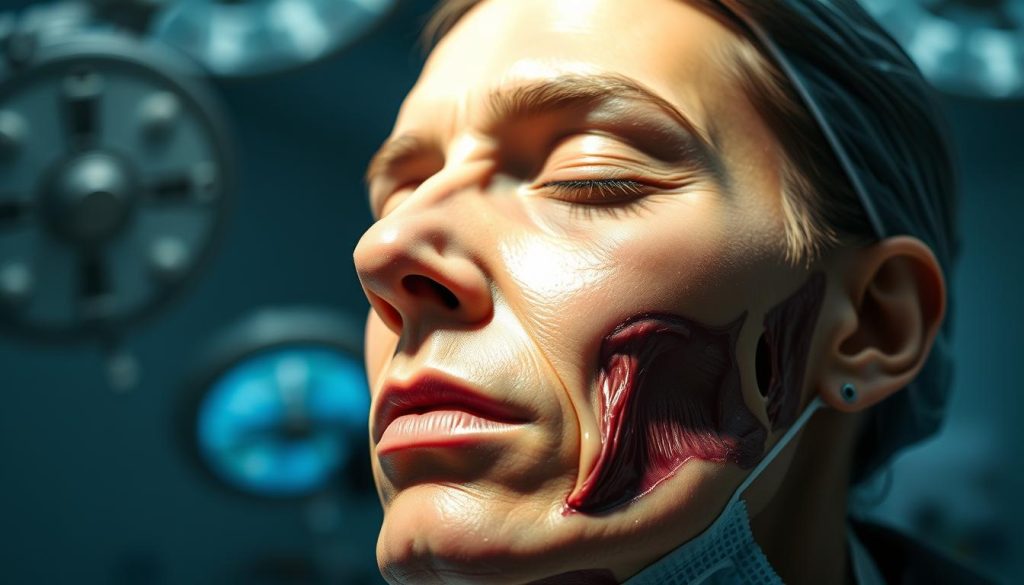Facial plastic surgery encompasses a wide range of procedures designed to enhance facial appearance, correct structural issues, or address signs of aging.
Modern facial plastic surgery techniques have evolved significantly, offering more natural-looking results with reduced recovery times compared to procedures of the past.
Patients considering plastic surgery must weigh both aesthetic goals and potential medical benefits against the risks and recovery requirements.
Key Takeaways
- Facial plastic surgery includes reconstructive and cosmetic procedures.
- Cosmetic facial plastic surgery enhances visual appearance.
- Modern techniques offer natural-looking results with reduced recovery times.
- Patients must consider aesthetic goals, medical benefits, and potential risks.
- New technologies and techniques continue to advance the field.
Understanding Face Beauty Surgery
Understanding the nuances of facial beauty surgery is crucial for individuals considering these procedures. Facial beauty surgery is a broad term that encompasses various surgical and non-surgical treatments aimed at enhancing or restoring the appearance and function of facial features.
Cosmetic vs. Reconstructive Procedures
Facial plastic surgery includes two main categories: cosmetic procedures that enhance appearance and reconstructive procedures that restore function and appearance after trauma, disease, or congenital conditions. Reconstructive procedures often address medical necessities and may be covered by health insurance, while cosmetic procedures are typically elective and self-funded.
| Procedure Type | Description | Insurance Coverage |
|---|---|---|
| Cosmetic | Enhance appearance | Typically not covered |
| Reconstructive | Restore function and appearance | Often covered |
Who Performs Facial Plastic Surgery
Board-certified facial plastic surgeons, otolaryngologists (ENT specialists), and plastic reconstructive surgeons are the primary medical professionals qualified to perform these specialized procedures. The training required for facial plastic surgeons is extensive, typically involving 5-6 years of specialized education beyond medical school.

Popular Face Beauty Surgery Procedures
Facial plastic surgery offers numerous procedures to address different concerns, ranging from reconstructive surgeries to cosmetic enhancements. These procedures can be broadly categorized into facial contouring surgeries, facial rejuvenation procedures, and non-surgical facial enhancements.
Facial Contouring Surgeries
Facial contouring surgeries are designed to reshape and redefine the facial structure. These include:
Rhinoplasty (Nose Reshaping)
Rhinoplasty is a surgery that reshapes the nose to improve its appearance and function, enhancing both aesthetics and breathing.
Facial Implants (Cheek, Chin, Jaw)
Facial implants enhance definition in the cheek, chin, and jaw areas, creating more balanced facial proportions.
Liposuction for Face and Neck
Liposuction targets excess fat deposits under the chin and along the neck, creating a more defined jawline and neck contour.
Facial Rejuvenation Procedures
Facial rejuvenation procedures aim to restore a youthful appearance by addressing signs of aging. These include:
Facelift (Rhytidectomy)
A facelift tightens loose skin and underlying muscles, particularly in the lower face and neck regions, providing more natural results.
Eyelid Surgery (Blepharoplasty)
Eyelid surgery removes excess skin and fat from the upper and/or lower eyelids, correcting drooping that may impair vision or create a tired appearance.
Brow and Forehead Lift
A brow and forehead lift address wrinkles and sagging in the upper face, rejuvenating the overall appearance.
Non-Surgical Facial Enhancements
Non-surgical facial enhancements offer less invasive alternatives with minimal downtime. These include:
Injectable Treatments (Botox, Fillers)
Injectable treatments like Botox and fillers address dynamic wrinkles and volume loss, providing a smoother and more youthful appearance.
Skin Resurfacing Options
Skin resurfacing procedures, such as chemical peels and laser treatments, help improve skin texture and appearance, reducing fine lines and wrinkles.
Benefits of Face Beauty Surgery
The advantages of facial plastic surgery are multifaceted, ranging from aesthetic improvements to functional enhancements. Facial beauty surgery can significantly improve an individual’s facial harmony and proportion.
Aesthetic Improvements
Facial plastic surgery offers significant aesthetic improvements by enhancing facial symmetry, proportion, and harmony. Procedures like nasal reshaping, eyelid lifts, and brow lifts can rebalance facial features, reduce signs of aging, and improve overall appearance. For instance, nasal reshaping can correct structural issues in the nose, improving both its appearance and functionality.
Functional Enhancements
Many facial plastic surgery procedures serve dual purposes, providing both cosmetic enhancement and functional benefits. For example, rhinoplasty can improve nasal appearance while also enhancing breathing capacity. Similarly, blepharoplasty can correct drooping eyelids, improving vision and reducing eye strain.

Beyond facial improvements, plastic surgery procedures like breast augmentation and tummy tuck can create more balanced body proportions, complementing facial enhancements for comprehensive aesthetic improvement.
| Procedure | Aesthetic Benefits | Functional Benefits |
|---|---|---|
| Nasal Reshaping | Rebalances facial features | Improves breathing |
| Eyelid Lifts | Reduces signs of aging | Improves vision |
| Brow Lifts | Elevates eyebrows, reduces wrinkles | Reduces forehead strain |
The psychological benefits of facial procedures often extend beyond appearance, with patients reporting improved quality of life, reduced social anxiety, and greater professional confidence following successful surgeries.
What to Expect: Risks and Recovery
Understanding the risks and recovery process is crucial for a smooth facial plastic surgery experience. Certain risks are associated with the procedure, including nausea, numbness, bleeding, and infection. To optimize healing, patients are advised to avoid smoking for two weeks before surgery.
Most plastic surgeries are performed on an outpatient basis, but some may require a short hospital stay. Before discharge, the surgeon will provide specific instructions for post-surgical care at home. Recovery timelines vary, with some procedures allowing a return to normal activities within days, while more extensive surgeries like facelifts may require 2-3 weeks of recovery.
It’s essential to have realistic expectations about the results of facial plastic surgery, understanding that while procedures like lip reshaping and scar revision can significantly improve appearance, they cannot achieve perfection. Insurance coverage typically applies to reconstructive procedures, such as breast reconstruction after mastectomy.
FAQ
What is the difference between cosmetic and reconstructive facial plastic procedures?
Cosmetic procedures aim to enhance the appearance, while reconstructive procedures focus on restoring function and normal appearance after an injury or birth defect. For instance, rhinoplasty can be performed for cosmetic reasons or to correct a breathing problem.
Who is qualified to perform facial plastic surgery?
A board-certified plastic surgeon or facial plastic surgeon has the necessary training and expertise to perform these procedures. They have completed extensive education and training in plastic and reconstructive surgery.
What are the benefits of forehead lift and eyelid surgery?
These procedures can help reduce signs of aging, such as wrinkles and sagging skin, resulting in a more youthful and refreshed appearance. Forehead lift can also help alleviate forehead wrinkles.
Are implants and liposuction safe?
As with any surgery, there are risks involved. However, when performed by a qualified surgeon, implants and liposuction are generally considered safe. It’s essential to discuss potential risks and complications with your surgeon.
Will insurance cover my rhinoplasty or other facial plastic procedures?
Insurance coverage varies depending on the procedure and individual circumstances. Reconstructive surgery, such as scar revision, may be covered if it’s deemed medically necessary.
What is the recovery time for tummy tuck and breast augmentation?
Recovery times vary depending on the individual and the procedure. Generally, patients can expect several weeks of rest and limited activity after tummy tuck or breast augmentation.
Can I undergo multiple procedures, such as facelift and neck lift, simultaneously?
Yes, combining procedures can be an effective way to achieve comprehensive rejuvenation. However, it’s crucial to discuss the risks and benefits with your surgeon to determine the best approach for your individual needs.
How can I minimize wrinkles and maintain a youthful appearance after surgery?
A consistent skincare routine, sun protection, and a healthy lifestyle can help maintain the results of your surgery. Your surgeon may also recommend non-surgical treatments, such as cheek fillers, to complement your results.
What is the role of chin and cheek implants in facial contouring?
Chin and cheek implants can enhance facial harmony by augmenting the underlying structure of the face. This can create a more balanced and defined appearance.
